WAVE FUNCTION COLLAPSE

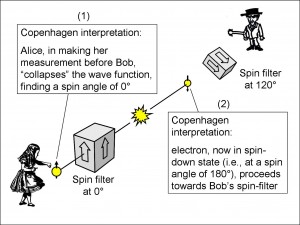
At the end of the Quantum Entanglement page, we were left with an extraordinary puzzle. If Alice and Bob make individual measurements on Venus and Mars respectively, and they choose the orientation of their measuring apparatus – their spin-filters – at the last moment, how can it be that their results are nevertheless correlated? In the particular instance where Alice and Bob set their spin filters at an angle of 120° to each other, they find that, on average, their results match ¾ of the time. By a “match”, we meant that Alice and Bob both measured an up-spin or they both measured a down-spin. (Remember that an up-spin at 120° meant an electron spin angle of 120° and a down-spin at 120° meant an electron spin angle of 300°.) We saw in the Hidden Variables page that you can’t account for their observations by assuming their electrons are emitted with some particular orientation or are otherwise “coded” with hidden variables. If there were such coding, we saw that the results could match no more than ⅔ of the time. If there were no such coding, then you would expect their individual results – uu, ud, du and dd – to match for only half of the time (that is, uu and dd are matching results, and ud and du are not). So how do you explain the high correlation?
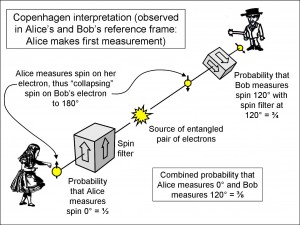
The (incorrect) Copenhagen interpretation of the EPR experiment
Niels Bohr and his “Copenhagenists” explained it this way: at the very moment when Alice measures the spin of her electron on Venus, the wave function of the entangled state of the two electrons collapses everywhere instantaneously. (We saw in the Quantum Entanglement page that the wave function for this experiment is a combined state of both electrons, called a singlet state.) Figure 1 shows the Copenhagen picture just after Alice has measured her electron with her spin filter set to the vertical and she has found a spin-up orientation (that is, an electron spin angle of 0º). The wave function has collapsed so that Bob’s electron now also has a defined spin in the vertical direction which will, of course, be spin-down (that is, Bob’s electron is now heading towards him with a spin angle of 180°). We say “of course” because we know that the total spin of this entangled state is zero, and so the spin of Bob’s electron has to cancel that of Alice’s.
We know, from Figure 15(b) in the Quantum Spin Filter page, that Bob has a probability of ¾ of detecting a 120º spin angle for his electron. (He has a corresponding probability of ¼ of detecting a 300° spin angle for his electron.) So the probability for the whole process – Alice detecting a spin angle of 0° with a probability of ½ and Bob detecting a spin angle of 120° with a probability of ¾ – is ½ x ¾ = ⅜ (see Figure 2).
That is the Copenhagen interpretation of Figure 6 of the Quantum Entanglement page. (Figure 2 is what I used in the first diagram of the arXiv paper.)
However, the Copenhagen interpretation is wrong! You can use relativity to show, in the context of entanglement, at least (but not only entanglement), that the wave-function concept cannot be considered as real. The rest of this page explains why.
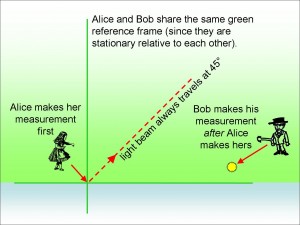
Look at Figure 3, where I have drawn a Minkowski space-time diagram of Alice and Bob making their measurements. This is simply Figure 3 of the page on Causality and Special Relativity, with the measurement at the origin being Alice’s measurement and the sunburst being Bob’s measurement. The diagram is drawn in Alice’s reference frame, but, since Bob is not moving relative to Alice, it is also his reference frame.
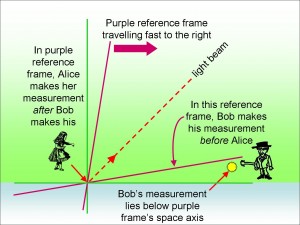
The reason why it is appropriate for the sunburst to represent Bob’s measurement is that it lies below the 45° light-beam path. It has to be below it because we need to have Bob making his measurement far enough away from Alice that she cannot influence his result. You may recall from the bottom of the page on Causality and Special Relativity that we can arrange for that by putting the sunburst event – Bob’s measurement, in this case – below the 45° light-beam path. This ensures that Alice could only influence Bob’s result by communicating faster than light, which, as we saw, would violate the principle of causality.
So, in this diagram, Alice makes her measurement first, followed by Bob.
However, at the bottom of the same page on Causality and Special Relativity, we came to an important conclusion, highlighted in italics, and reproduced here: if two events are separated in space so far apart that one cannot cause the other even using information travelling at the speed of light, then you can always find two frames of reference in which the events happen in a different order.
The meaning of this is that, in the present experiment, if you are on a spaceship travelling in the direction from Alice towards Bob at a sufficiently great speed, then, in your frame of reference, Bob makes the first measurement, and not Alice. I have drawn the time and space axes of your frame of reference in purple in Figure 4. You can see in this diagram that the sunburst – Bob’s measurement – is below the purple space axis, which means that it happens before Alice makes her measurement (which happens at the origin).
So, if I am to use the Copenhagenists’ picture of wave-function collapse in the purple reference frame (which is just as valid as Alice and Bob’s reference frame), then, instead of saying that Alice collapses the wave function by the action of her measurement (which is what happens in Alice and Bob’s reference frame), I have to say that Bob collapses it, since it is he who makes the first measurement (in the purple reference frame).
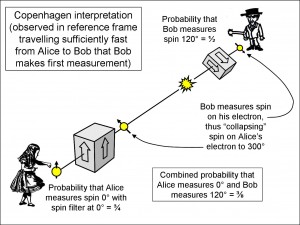
In Figure 5 I have redrawn Figure 2, except that, now, Bob makes the first measurement and so it is he, and not Alice, who collapses the wave function. Since Bob had set his spin-filter at an angle of 120º, and since we are looking at the case, shown in Figure 2, where Bob finds an electron spin angle of 120°, then, from the collapsing-wave-function theory, his measurement collapses Alice’s incoming electron to an electron spin angle of 300º (because this is in the opposite direction to 120°).
When the “collapsed” electron reaches Alice’s spin-filter, which is vertically inclined at 0º, there is a probability of ¾ that she will measure a spin angle of 0° (which you can work out by looking at Figure 15(b) in the Quantum Spin-Filter page and rotating the whole set-up through 120°, keeping in mind that the electron in that figure is travelling from left to right, whereas it is travelling from right to left in the current figure). So, just as in the first frame of reference, the probability for the whole process – Bob detecting a spin angle of 120° with a probability of ½ and Alice detecting a spin angle of 0° with a probability of ¾ – is, again, ½ x ¾ = ⅜.
Now compare Figures 2 and 5 for the probability that both Alice and Bob will agree on the spin orientation (that is, spin-up at 0° for Alice and spin-up at 120° for Bob). In either case, the probability is the same regardless of whether we view the experiments from a stationary frame or a moving one. This is how it should be. However, the pictures of the collapsed electron in the two diagrams differ from each other. In Figure 2, the collapsed electron (Bob’s electron once Alice has made her measurement) is heading for Bob with a spin angle of 180º while, in Figure 5, the collapsed electron (Alice’s electron once Bob has made his measurement) is heading for Alice with a spin angle of 300º.
These two pictures cannot both be real. In special relativity, reference frames that are moving with a steady speed, like the ones we have used here, are all equally valid: you are not allowed to favour one over the other. Therefore, neither picture can be real. So the Copenhagen picture of wave-function collapse cannot be real.
Click here to go to [9] Many Worlds page
